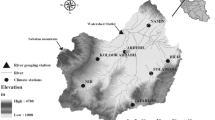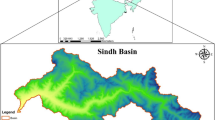Abstract
When applied to hydrology, the artificial neural networks (ANN) offer multiple advantages over conventional rainfall–runoff models. It was very interesting to assess the ANN performance over one of Mount Lebanon watersheds characterized by their nonlinear hydrologic regime due to the karstic nature, geomorphology and heterogeneous precipitation of rain and snow. The time delay neural network (TDNN) models in this study were assessed for their ability to simulate highly karstified watershed with little precipitation data, especially concerning snow contribution and for their ability to simulate fluctuated river flows. The selected watershed for this study was Nahr Ibrahim watershed with an area of 329 km2 and an upper part located above 1700 m altitude taking part of the Cenomanian Plateau of Mount Lebanon. This karstic plateau is a stage for snow accumulation during winter and snowmelt during spring. The snowmelt is discharged by underneath karstic springs of Afqa and Roueiss, main contributors to Nahr Ibrahim flow. To achieve a better comprehension of the hydrologic regime, annual simulations with daily time step were conducted in this study. A simple snowmelt model was coupled with TDNN model (A) to makeup the lack of snow data. Model (A) which registered a considerable performance Nash criteria reaching 0.73 for the karstic springs and 0.66 for the watershed. However, two other methods were applied: the first, model (B), using BFImax separation method which yielded a high performance of 0.95 and the second, model (C) with spring flows as input data which yielded 0.87. In this study, only nonlinear input output neural network was applied to avoid autoregressive models which would have definitely returned higher performances due to the long term rainfall–runoff correlation of the springs.
Access this chapter
Tax calculation will be finalised at checkout
Purchases are for personal use only
Similar content being viewed by others
References
Aouad-Rizk, A., Job, J., Khalil, S., Touma, T., Bitar, C., Bocquillon, C., & Najem, W. (2005). Snow in Lebanon: a preliminary study of snowcover over Mount Lebanon and a simple snowmelt model. Hydrological Sciences Journal, 50(3), 555-569.
COE. (1956). Snow hydrology. Portland, OR: United States Army, Corps of Engineers.
Dreyfus, G. et al. (2002). Réseaux de neurones: Méthodologie et applications.
Eckhardt, K. (2005). How to Construct Recursive Digital Filters for Baseflow Separation. Hydrological Processes, 507-515.
Hornik, K. (1991). Approximation Capabilities of Multilayer Feedforward Networks. Neural Networks, 251-257.
Hreiche, A. (2003). Modelisation Conceptuelle de la transformationpluie-debit dans le contexte mediterranéen. Montpellier: University of Montpellier.
Hreiche, A., & Najem, W. (2007). Hydrological impact simulations of climate change on Lebanese Coastal Rivers. Hydrological Sceinces Journal, 1119-1133.
IGH. (2012). International Glossary of Hydrology. WMO.
Iyer, M. S., & Rhinehart, R. R. (1999). A Method to Determine the Required Number of Neural-Network Training Repetitions. IEEE TRANSACTIONS ON NEURAL NETWORKS, 427-432.
Johannet, A. (1994). Subterranean Water Infiltration Modelling by Neural Networks :. ICANN. Sorrento.
Kong A Siou, L., Johannet, A., Borrell, V., & Pistre, S. (2011). Complexity selection of a neural network model for karst flood forecasting: The case of the Lez Basin (southern France). Volume 406,(Issues 1–2).
Nash, J., & Sutcliffe, J. (1970). River flow forecasting through conceptual models part I. Journal of Hydrology, 282-290.
Waibel, A., Toshiyuki, H., & Geoffrey, H. (1989). Phoeneme Recognition Using Time-Delay Neural Network. 37(3).
Yamashita, Y. (1997). Time Delay Neural Networks for the Classification of Flow Regimes. 21.
Zurada, J. M. (1992). Introduction to artificial neural systems application of neural network to rainfall runoff modeling. New York: West Publishing Co.
Zuzel, J., & Cox, L. (1975). Relative importance of meteorological variables in snowmelt. Water Resources Research, 11(1):174-176.
Author information
Authors and Affiliations
Corresponding author
Editor information
Editors and Affiliations
Rights and permissions
Copyright information
© 2017 Springer International Publishing Switzerland
About this paper
Cite this paper
Allam, A., Najem, W. (2017). Artificial Neural Networks Modeling of a Karstic Watershed in Mount Lebanon. In: Renard, P., Bertrand, C. (eds) EuroKarst 2016, Neuchâtel. Advances in Karst Science. Springer, Cham. https://doi.org/10.1007/978-3-319-45465-8_21
Download citation
DOI: https://doi.org/10.1007/978-3-319-45465-8_21
Published:
Publisher Name: Springer, Cham
Print ISBN: 978-3-319-45464-1
Online ISBN: 978-3-319-45465-8
eBook Packages: Earth and Environmental ScienceEarth and Environmental Science (R0)




